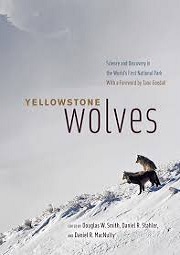Yellowstone Wolves: Science and Discovery in the World’s First National Park

D. W. Smith, D. R. Stahler and D. R. McNulty (Eds.)
University of Chicago Press, £26.50
The last native wolf in Yellowstone National Park was shot in 1926. This anthropogenic intrusion on a major wildlife habitat in North America generated controversy over the US Government’s policy of wolf (and other animals detrimental to agriculture and animal husbandry) extermination. In 1995 the policy was reversed and wild wolves from Canada and Montana were reintroduced.
Subsequently, many studies on the wolves and their impact on faunal and floral components of Yellowstone have been undertaken. This is reflected in the fact that there are 79 contributors to this book. The two chapters of Part I recount the wolf history of Yellowstone National Park, which is located in the western USA, comprises 8,983 km²; and was founded in 1871. These chapters emphasise the ecological role of wolves and why and how elimination and reintroduction occurred.
Part II comprises four chapters focused on wolf behavioural and population ecology. Topics include wolf biology, family dynamics, territoriality, population dynamics and demography. The three chapters of Part III highlight genetics and disease in wolf populations, including the rise of the black wolf. Part IV comprises five chapters which concentrate on wolf – prey relationships such as those with elk and bison, evidence for levels/types of predation and evidence e.g. tooth wear, and repercussions for prey populations.
This is followed by two chapters in Part V on ecosystem effects and species interactions. Topics comprise impacts on vegetation and relationships between carnivores. The final part, with three chapters, considers conservation, management and the human experience i.e. wolf watching, plus future prospects.
The huge volume of information presented in this book, plus illustrations, diagrams, and an extensive bibliography, underpin its significance to ecological research as do the many contributors; several guest essays add useful overviews. It is a fitting tribute to the 100 years plus of research pre and post wolf reintroduction, and a sound basis for future studies.
Dr A M Mannion


